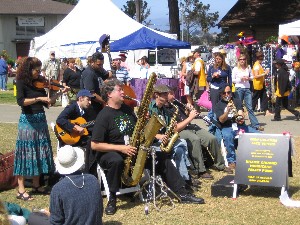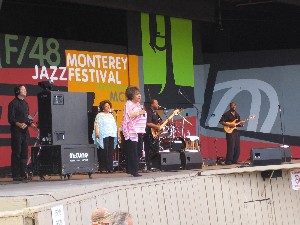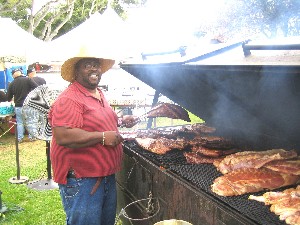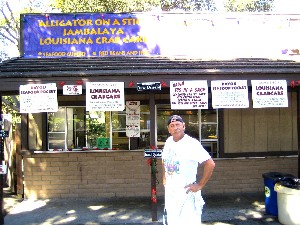Special Feature: Products Sally Recommends
On California's Central Coast Appetites are Fulfilled at the Monterey Jazz Festival
 Each September on California’s spectacular Monterey Peninsula, about 130 miles south of San Francisco, more than 35,000 jazz fans gather for a long, satisfying weekend at a park-like local fairgrounds to enjoy some of world’s leading artists practicing this native American art form. The dedicated and knowledgeable crowd attends the Monterey Jazz Festival, the oldest (circa 1957), continuous event of its kind in the world.
Each September on California’s spectacular Monterey Peninsula, about 130 miles south of San Francisco, more than 35,000 jazz fans gather for a long, satisfying weekend at a park-like local fairgrounds to enjoy some of world’s leading artists practicing this native American art form. The dedicated and knowledgeable crowd attends the Monterey Jazz Festival, the oldest (circa 1957), continuous event of its kind in the world.
The non-profit Festival supports jazz education programs and is run by a local board of directors that includes movie legend Clint Eastwood. Eastwood lives a few miles away in Carmel where he was mayor a few years ago. Recently, the critically-acclaimed Monterey Jazz Festival celebrated its 48 th birthday and over those years almost every major jazz artist from Louis Armstrong to Wynton Marsalis has performed there. These days the Festival, on the 20-acre, grassy fairgrounds site, enjoys such a high reputation that tickets to its five outdoor arena concerts, with offerings on several other smaller stages, sell out months in advance.
In September, 2005, the artists who performed for the sell-out crowd included Tony Bennett, Sonny Rollins, Branford Marsalis, John Handy, Madeleine Peyroux, Mavis Staples, Pat Metheny, Carla Bley, Larry Carlton, Lee Ritenour, Dave Grusin and even a group from hurricane-devastated Louisiana called the New Orleans Jazz Vipers.
 Tony Bennett proved to be an enormous crowd pleaser. After each jazz song he grasped his hands chest high and looked out over the audience as though he were saying “Look at me. I’m an old saloon singer and you still like me, and I’m thrilled that you do.” It was a bravura performance. Saxophonist John Handy reprised his famous work, Spanish Lady, which he introduced at the Monterey Jazz Festival 40 years ago. But let’s leave the music reviewing to the music reviewers and move to outdoor festival dining.
Tony Bennett proved to be an enormous crowd pleaser. After each jazz song he grasped his hands chest high and looked out over the audience as though he were saying “Look at me. I’m an old saloon singer and you still like me, and I’m thrilled that you do.” It was a bravura performance. Saxophonist John Handy reprised his famous work, Spanish Lady, which he introduced at the Monterey Jazz Festival 40 years ago. But let’s leave the music reviewing to the music reviewers and move to outdoor festival dining.
Loyal fans attending the Monterey Jazz Festival year after year stay in nearby motels, inns, and Victorian bed and breakfasts. But although the Monterey Peninsula is well-known for fine restaurant dining, most attendees choose to remain on the fairgrounds much of the time, not just to savor the music but to dine alfresco at picnic tables in the shade of elegant oaks trees. So how do you feed a crowd of hungry jazz aficionados? Very well, indeed!
As usual, more than 30 colorful food stands dotted a trail between the clipped lawns and served an eclectic selection of offerings---many created with local produce, meat or fish. Of course, there was barbecue; in fact several stands served different types. One, run by a loquacious Texan named Emmanuel Sims, offered not only Texas-style, sweet but vinegary pork ribs, but also flavorful beef tri-tips which local butchers first prepared as juicy beef roasts in nearby Santa Maria, south of the city of Monterey.
 When asked where he picked up the art of barbecuing, Emmanuel replied, “From my mother and father back in Waco. We even had barbecue for breakfast.” Emmanuel operates his own restaurant in Sacramento now and is on call each year to cater Super Bowl events. Understandably, he won’t reveal his smoking methods or the recipe for his marinade. But he did say that he first “dry rubs” his ribs, chicken and tri-tips with his own sauce, a mixture of garlic, pepper, salt and chilies. Later, while it is smoking over oak charcoal, Emmanuel “wet rubs” the meat frequently with a mixture that includes red wine and teriyaki sauce. He was vague about details and we respect that. This diner favored the pork ribs; powerful, smoky and almost falling off the bone.
When asked where he picked up the art of barbecuing, Emmanuel replied, “From my mother and father back in Waco. We even had barbecue for breakfast.” Emmanuel operates his own restaurant in Sacramento now and is on call each year to cater Super Bowl events. Understandably, he won’t reveal his smoking methods or the recipe for his marinade. But he did say that he first “dry rubs” his ribs, chicken and tri-tips with his own sauce, a mixture of garlic, pepper, salt and chilies. Later, while it is smoking over oak charcoal, Emmanuel “wet rubs” the meat frequently with a mixture that includes red wine and teriyaki sauce. He was vague about details and we respect that. This diner favored the pork ribs; powerful, smoky and almost falling off the bone.
A plate of Emmanuel’s ribs or chicken goes well with what many festival-goers liked to pick up at another food stand---deep-fried artichoke hearts from “chokes” grown only a few miles away in Castroville, which proclaims itself the artichoke capital of the world.
Then there were Nita Bee’s pies, cakes, cobblers, cookies and puddings. And, Nita herself, who lives in San Jose, was right there to serve them; still warm from her portable oven---with vanilla ice cream, if you like. The high point in Monterey Jazz Festival dining for me that weekend was Nita Bee’s sweet potato pie. In an interview with this reporter, who questioned her between bites of that magnificent pie, Nita said she learned how to bake from her father and from what she learned in home economics class when her family lived in Southern California. “I was a Daddy’s girl,” she said, “and he really got me started by showing me how he made sweet potato pie.”
 When I asked for the recipe she grinned and said, “Now, you know I won’t give you that, and even if I did, I would hold out on one ingredient. It’s my secret ingredient and I put it into everything I bake.
When I asked for the recipe she grinned and said, “Now, you know I won’t give you that, and even if I did, I would hold out on one ingredient. It’s my secret ingredient and I put it into everything I bake.
“What if I guess what your secret ingredient is?” I said.
“You won’t,” she said. “It’s something you can buy right off the shelf, but it’s something you would never associate with baking.”
I gave up and just enjoyed my pie.
For the last several years an inspired team from New Orleans called Louisiana Cookery had presented Cajun specialties---fiery gumbos, etouffees and jambalayas---with crawfish, shrimp, chicken, and andouille sausage. And for the adventurous there was even alligator on a stick. And, of course, red beans and dirty rice---that tasty, all-purpose Cajun specialty prepared with chicken gizzard and giblets, sausage meat, onions, bell peppers and a variety of Cajun spices including cayenne pepper.
This year, 2005---the year of Hurricane Katrina---it was touch and go for the team from Louisiana Cookery. They were almost unable to be at the Festival. We talked to head man Robert St. Thomas. “We almost didn’t make it. Katrina had us on the ropes. Monterey Jazz Festival officials helped us to get here and we appreciate it,” he said.
St. Thomas, originally from Massachusetts, went to New Orleans in 1971 for Mardi Gras and never left. “I fell in love with New Orleans,” he said.
A graduate of the Culinary Institute of America in Hyde Park, New York, St. Thomas said the training there gave him the basics but he really learned how to cook Cajun style when he fell under the influence of legendary Louisiana chef Paul Prudhomme. Later St. Thomas opened three different food operations in his adopted home town; first an all-night deli and then a bar and restaurant. “Finally I got it right,” he says and he opened Louisiana Cookery, a catering operation that travels around the country participating in various events where hungry audiences gather.
For the past few years at the Monterey Jazz Festival we have been intrigued by Louisiana Cookery’s alligator on a stick. We had to try it. No it doesn’t really taste like chicken. It taste like…well, alligator. That is, it has a distinctive taste (I was reminded of rabbit) and is mild and lean. St. Thomas, who says he purchases what he calls “nuisance alligators,” marinates them in white wine, dry mustard and a Louisiana product called Crystal Hot Sauce. He adds Cajun spices that include file’ powder prepared from the dried leaves of the sassafras tree. He would not go beyond this. Then he deep fries long strips of the marinated alligator and skewers them on bamboo much like Asian satay.
His seafood gumbo is a bowl of a thick stew with fresh prawns, red snapper and crayfish. His jambalaya is basically a rice dish with chicken and hot Louisiana sausage, pork loin, onions, garlic and peppers, all simmered in a chicken stock.
St. Thomas’s traditional Louisiana bayou Crayfish etouffee deserves a special mention. And by the way St. Thomas pronounced this as “a-2-fay.” Crayfish tail meat is simmered in butter. Aromatic vegetables are added, then minced garlic, tomato sauce, white wine and, of course, those Cajun spices. This is served over rice.
But then as a conclusion to our interview St. Thomas said “Of course, it’s all about the roux, isn’t it?”
“Is it?” we asked waiting for a few pointers.
“Of course, you can’t prepare anything Louisiana-style without making a proper roux first.
The interviewer had the presence to keep quiet, knowing St. Thomas would continue.
“I make it with a hunk of bacon fat and a bit of butter. Then I sift in some flour and my spices, slow and easy like, and stir like a Mardi Gras demon.”
“How long do you stir it?”
“Ah, that’s the art; to know just how long to stir it. It needs to be a deep brown, but not black.”
And that ended my interview with Robert St. Thomas.
Elsewhere on the grounds of the Monterey Jazz Festival there was fried chicken, clam chowder, corn on the cob, baked potatoes, Thai satay, Chinese noodles, Indian curries with a lot of authority, burritos, and inevitably, hot dogs. But let’s close with those hot dogs. Called Le Dogs, these are foot-long, all beef franks stuffed into a hole in a French baguette that has been skewered on a stainless steel spike. Mustard is squirted into the hole (catsup too if you wish) and the wonderful, self-contained package never drips into your lap.
Monterey County wines were available by the glass, as is Korbel champagne from California’s Russian River area to the North. As a beverage my daughter Laurel favored the wonderful creation, Orange Julius; not just orange juice, it has a bit of milk and vanilla extract to give it character.
No one goes hungry or thirsty at the Monterey Jazz Festival.
![]()
Ernest Beyl is a San Francisco writer (and jazz fan) who has attended the Monterey Jazz Festival for many years. Obviously, he not only likes the music but the dining as well.
Note: This information was accurate when it was published. Please be sure to confirm all rates and details directly with the businesses in question before making your plans.



